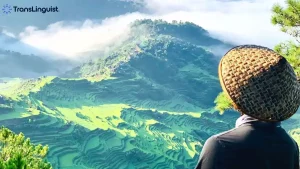The languages of the Philippines carry the country’s history across islands, trade routes, and migrations. For market-entry teams and community programs, language isn’t a backdrop; it’s the map. Filipino and English power national life, but regional languages shape how people learn, shop, work, and seek help every day. If your brand wants to be understood the first time, your content and support playbooks should follow how people actually communicate: a national core, plus local voices where your customers live. TransLinguist helps teams apply that mix with services that respect both local speech and national standards.
Population, Languages, and Who Speaks What
Back in 2020, the Philippines had a little over 109 million people; a few years later, the figure comfortably topped 110 million. Switching between languages is everyday life. At home, people speak their local tongue; for national matters, they move to Filipino; and for school, courtrooms, and work with global partners, English steps in. The country recognizes both Filipino and English as official. Filipino, built on Tagalog and enriched by other local languages, anchors government, classrooms, and media. English remains common in the courts, universities, business, and the outsourcing sector.
To plan campaigns and service coverage, it helps to know how language is used at home. Household data indicate Tagalog is the most common home language nationwide, followed by Bisaya/Binisaya and other major regional languages. For broad reach, lead with Filipino and English; for deeper engagement, add the regional language where you operate. That layered approach respects policy while matching daily life.
Major Languages and Approximate Scale
Here’s a practical snapshot of the largest regional languages by households that report using them at home, with directional audience estimates based on the 2020 average household size. Treat these as planning inputs; proficiency and bilingual patterns differ by region.
- Tagalog / Filipino ~10.5 million households (≈ 43 million people). Filipino is the national standard for media and education; Tagalog remains the largest first-language base.
- Bisaya / Binisaya / Cebuano ~4.2 million households (≈ 17 million people when counted separately for Bisaya/Binisaya and Cebuano entries). Strong across Central Visayas, parts of Eastern Visayas, and much of Mindanao.
- Hiligaynon (Ilonggo) ~1.9 million households (≈ 8 million people). Concentrated in Western Visayas and parts of Mindanao.
- Ilocano ~1.86 million households (≈ 7.6 million people). Northern Luzon with sizable migrant communities nationwide.
- Bicol (Bikol) ~1.0 million households (≈ 4.2 million people). Bicol Region.
- Waray ~0.7 million households (≈ 2.9 million people). Eastern Visayas.
- Kapampangan, Pangasinan, Maguindanaon, Tausug, and Maranao hundreds of thousands of households, are anchored in Central Luzon and Muslim Mindanao.
The takeaway: one national message rarely fits every province. Publish core materials in Filipino and English, then localize high-stakes contenthealth, billing, eligibility, and disaster preparation, into the dominant regional language for each city or province.
Where Else Are Philippine Languages Spoken?
Filipino communities abroad reinforce demand for content and service in Philippine languages beyond the archipelago:
- U.S.: Tagalog/Filipino = top non-English; Ilocano leads in Hawaiʻi (Northern Luzon migration).
- Canada: Tagalog is growing quickly, strong in ON, BC, AB, and MB.
- Gulf/East Asia: Filipino labor corridors (UAE, Saudi Arabia, Qatar, Kuwait, Singapore, Japan, Hong Kong) → steady need for Tagalog/Filipino, Cebuano/Bisaya, English in banking, retail, health, and public sectors.
For brands with global operations, these diaspora hubs are prime locations to pilot bilingual support and targeted messaging.
Digital Growth: How Filipinos Connect Now
The Philippines is intensely online and unmistakably social-first. Most journeys start on a phone; short video sparks discovery; streaming is part of the daily routine; and social inboxes double as service counters. Design around that reality: build pages that load quickly on mid-range devices, publish video with captions or subtitles by default, and keep bilingual DM and chat staffed so complex issues can move to voice or video without friction.
Cultural Legacy: What Shapes Voice and Meaning
Cultural context matters: Austronesian roots, Spanish/American layers, strong local traditions. Sinulog and Ati-Atihan anchor January with Santo Niño celebrations and civic energy. Baybayin is resurfacing in public design and curriculum debates. Build campaigns around these signals, calendar, visuals, and tone to win attention and fit the moment.

Religion: The Social Backdrop
Faith life is visible: a large Catholic population, significant Muslim communities, and diverse Protestant and independent churches. Calendar effects are real plan launches and field work with Holy Week, feast days, and Eid in mind.
Economic Apex: What Powers Demand
Services now set the pace: IT-BPM, finance, retail, logistics, and tourism. Electronics still carries export earnings. Money sent home by overseas Filipinos has reached new highs, steadying household budgets and keeping stores busy from Luzon to Mindanao. Despite severe weather, the growth track has held. Mid-range forecasts still place the Philippines among the region’s quicker expanders. For brand planners, that means demand is spreading into tier-two and tier-three cities, where day-to-day buying happens in regional languages.
Stake in Regional Geopolitics
A founding ASEAN state and U.S. ally (1951 MDT), the Philippines also backs the 2016 UNCLOS arbitration ruling. EDCA sites have expanded, and officials reiterate MDT coverage for attacks on Philippine forces, vessels, or aircraft in the South China Sea. Net effect: implications for trade routes, infrastructure, and supply-chain risk planning.
What This Means for Business: Practical Language Moves
-
- Publish your core web, app, policy, and help content in Filipino and English.
- For health, finance, safety, and government programs, add regional versions where you operate (Cebuano/Bisaya, Hiligaynon, Ilocano, and others).
- Match honorifics and address forms; avoid translations that read overly formal or “foreign.
- Treat video as default: captions/subtitles in Filipino and relevant regional languages; keep terms aligned to your approved glossary.
- Start chat and phone triage in Filipino/English, then route complex cases to regional-language agents or interpreters.
- For field events, schedule around religious/cultural calendars and bring handouts in the local dominant language.
- Publish your core web, app, policy, and help content in Filipino and English.
TransLinguist: How We Help You Execute
We support national programs and local launches with interpreters, translators, editors, and subtitle specialists who understand the Philippines’ language landscape. We build clear term lists for product names, legal and clinical language, and your UI. Then we translate or transcreate your site, app, and campaigns and add live captions with multilingual subtitles for events and trainings. Remote simultaneous interpreting supports live sessions, while on-site teams cover town halls and briefings. Communications are audience-specific, and participants depart with actionable instructions.
Services at a glance
- Translation into Filipino, Cebuano/Bisaya, Ilocano, Hiligaynon, and other regional languages
- Localization for marketing, legal/policy, and product interfaces
- Live captions and subtitles for broadcasts, webinars, and training libraries
- Voice-over for explainers and learning modules
- Video Remote Interpreting and on-site interpreting, including sign language where appropriate
- Terminology and style management that preserves brand voice across languages
Conclusion
Philippine languages are living systems, carriers of pride, memory, and practical guidance. National standards let you coordinate policy and commerce. Regional voices let you be understood in daily life. Brands that design for both earn trust faster and spend less correcting misunderstandings. If your next launch or public program depends on clear communication across provinces and islands, TransLinguist can help you plan the sequence, set the glossary, and deliver the mix of services people will actually use.
FAQs
What is the most useful language for nationwide reach?
Filipino and English together cover government, education, and national media. Use them for baseline clarity, then add the regional language when precision and trust are essential.
Is English alone enough for product or policy content?
English is common in contracts and higher education, but regional versions prevent errors and reduce back-and-forth. Many teams publish concise regional summaries alongside full Filipino or English documents.
Do subtitles really improve training outcomes?
Yes. Captions and subtitles help people review new terms and steps at their own pace, which improves retention and lowers coaching effort for supervisors.
Where should we start with regional languages?
Map your service areas to dominant languages (e.g., Cebuano in Central Visayas and much of Mindanao; Hiligaynon in Western Visayas; Ilocano in Northern Luzon). Prioritize high-stakes flows first: billing, eligibility, safety, and returns.



